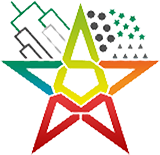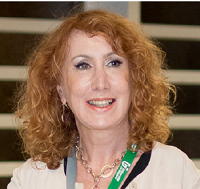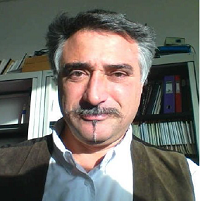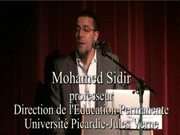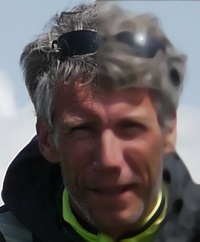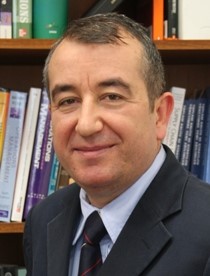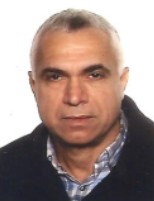Conférences PlénièresKeynote Speakers 1
Christine Fernandez-Maloigne & Noël Richard XLIM Laboratory – Joint Research Unit (JRU) 7252 of CNRS University of Poitiers -France Titre de la conférence : New challenges for imaging: between objective metrology and perceptual metrology Abstract: Since the work of Julesz many psycho-physical experiments allowed to define and improve a model of the human visual system. Thanks to these results, several recommendations have been provided to estimate color differences, contrasts, to improve the quality of the image rendering... These works define a subjective metrology, related to the human observer. They are at the heart of the definition of appearance models at the center of lot of current research activities: color appearance, appearance of materials, texture and perception. In parallel, the hyperspectral sensors provide images based on a fine spectral and spatial sampling, allowing a direct access to the optical and physical properties of the observed surface. In another hand, multispectral and color sensors combine different spectral sensitivity functions in a non-independent way, as the human eye. In 2016, the first metrologically valid similarity metrics between spectra was introduced. Thanks to this breakthrough, several metrological analysis tools of the hyperspectral images were constructed. This construction defines an objective metrology based on the physical and optical content of the observed surfaces. More recently, in 2018, for the first time the channel interdependency of a color or multispectral sensor was considered in order to extract the gradient from an image. The proposed expression, the Full-Vector Gradient, is generic whatever are the channel count or the channel interdependency. Hence it is adapted from color domain to the hyperspectral domain. But the expression is also adapted to address the question of the gradient detection in the LMS, so the human color space. From these two innovations in the hyper and multi-spectral domain, it is possible to imagine the convergence of subjective and objective metrology, by a precise measurement of the observed stimuli by the human visual system in terms of spatio-chromatic content and considering the LMS channel interdependency of human visual system. Biography: Christine Fernandez-Maloigne is currently Vice-Rector of Poitiers University, in charge of International Relations and director of a CNRS research federation (MIRES), which gathers 560 researchers in the south west of France, in the area of mathematics, image processing, computer graphic, computer science and communication systems. Her research activities are focused on color imaging, including fundamental researches about introduction of human visual system models in multiscale color image processes as well as practical applications for biomedical, patrimonial and audio-visual digital contents. Christine Fernandez-Maloigne is now appointed member of the National Council of the French Universities (CNU), secretary of division 8, Image technologies, of the CIE (International commission of Lighting) and deputy Editor-in-chief of JOSA A. Biography: Dc. Noël Richard, male, is an Assistant Professor at University of Poitiers, France. Since 1992, he is a researcher at XLIM laboratory, UMR CNRS 7552, SIC (Signals, Images and Communications) department. He is working on color and hyperspectral image processing since more 20 years. His research activity is focused on the integration of the metrological purpose in image analysis and processing in the perceptual domain (tri-chromatic case) and physical domain (hyperspectral case). Since July 2015, Noël RICHARD is the Technical Committee Chair of the TC8-14 of the International Committee of Lightning (CIE) that is in charge of the “Specification of Spatio-Chromatic Complexity”. The results of this technical committee will provide the first elements to develop validate the metrology of non-uniform surfaces, one of the most important challenge for the next decade in Vision and Quality Control. Since October 2016, he leads the French ANR project DigiPi (Digital Pigments: from color in Cultural Heritage to industrial requirements in Spectral Metrology) in order to develop the metrological tools required to analyze and process the hyperspectral measurements and images.
Keynote Speaker 2
Mohamed Nadif Titre de la conférence: Dimensionality reduction and clustering: issues and challenges Abstract: Dimensionality reduction and clustering remain two of the major problems in machine learning and data science. Clustering aims to group data points by similarity between their features while dimensionality reduction aims to group features that are high correlated. To perform clustering while overcoming high dimensionality, combining sequentially both approaches is a procedure commonly used; this approach is referred to as Tandem Approach. Combining Principal Component Analysis (PCA) as basic method for clustering with k-means is certainly the most popular procedure. Tandem approach can rely on other nonlinear dimensionality techniques including autoencoders and other clustering algorithms. However, such approaches present some drawbacks due principally to the sequential use of both objectives --dimensionality reduction and clustering--. In this talk we review the different approaches used in recent years to overcome these drawbacks by combining simultaneously dimensionality reduction and clustering. Biography: Mohamed Nadif is full Professor of statistics, data science and machine learning at University Paris Descartes. He is the head of "Machine Learning for Data Science" (MLDS) team at LIPADE since 2006. For twenty years, he supervised many theses on statistics and machine learning on theoretical and applied subjects with industries. He published in leading machine learning and data science conferences such as ICML, AAAI, SDM, ICDM, AISTATS, ECML, CIKM, SIGIR, PAKDD and journals such as TNNLS, TPAMI, TKDE and Pattern Recognition. He has more than 150 publications and is the one of the two authors of the book (Wiley Ed) entitled «Co-clustering: Models, algorithms and applications», 2013. He teaches machine learning techniques and multivariate analysis in master "Machine Learning for Data Science" that he has created and continue to supervise since 2009. He is a regular member of the program committee in international conferences including ECML, AAAI, IJCAI and IDA, reviewer in prestigious journals such as IEEE Pami, IEEE TNNLS, and Pattern recognition, associate editor of the “Advances in Analysis and Classification” journal. His current researches interests include cluster analysis, co-clustering, dimensionality reduction, factorization latent block models, text-mining, recommender systems and deep learning. He was Invited by Amirkabir University (Teheran-IRAN) and China University of Petroleum (Huangdao-China), and several French and international conferences. Since 2012, he is the president of the French speaking Society of Classification (SFC) which is a member of IFCS (International Federation of Classification Societies). He has been awarded many grants such as ANR ClasSel- 2008-2012 on co-clustering and model selection and EDAGWAS 2013-2015 devoted to develop a set user-friendly and fast data analysis tools to explore both association between genome-wide SNP data, disease and textual relationships among genes. He is a contributor of the “Coclust” software providing diagonal and non-diagonal co-clustering algorithms developed in the MLDS team and exclusively dedicated to high-dimensional sparse data. http://www.math-info.univ-paris5.fr/~nadifmoh/
Keynote Speaker 3
Mohamed Sidir Titre de la conférence : La formation à distance à l’ère du Mooc : tensions et contradictions Résumé : « Sur la base d’une analyse diachronique d’un dispositif de formation à distance universitaire français, nous souhaitons apporter un éclairage sur les enjeux qui traversent la réalité de ce dispositif, centré pendant plusieurs années sur des processus d’innovation pédagogique, technique et organisationnel pour aboutir, par des jeux d’acteurs complexes, à une rationalisation et une bureaucratisation qui prônent l’autonomie des étudiants et questionnent les modes des régulations de la formation et la gouvernance des universités. Le cas l’enseignement supérieur marocain sera évoqué pour éclairer les analyses d’un double point de vue » Présentation de l’intervenant : Mohamed Sidir, professeur à l’université de Picardie, a développé la plate-forme Interactif E-learning System (INES) et a dirigé le service de formation à distance au sein de son université. Expert international sur la question des TICE, M. Sidir a dirigé l’université numérique régionale de la Picardie de 2008 à 2012. Chargé de mission FOAD à l’université d’Amiens,il dirige aujourd’hui l’axe de recherche « Savoirs et TIC » au Centre Universitaire de Recherches sur l’Action Publique et Politique et il est le premier vice-président du Conseil National des Universités (CNU)en sciences de l’information et de la communication au ministère de l’enseignement supérieur français.
Keynote Speaker 4
Philippe CARRE Titre de la conférence : Application of the Quaternionic Wavelet transform and the Machine Learninig algorithm for a new decoding process Abstract: In this presentation, we propose to describe the application of the Quaternionic Wavelet transform and the Machine Learning algorithm for a new decoding process to to improve the Quality of Experience (QoE) in a wireless transmission context. The algorithm uses the magnitude and the phase information in the Quaternionic wavelet domain as the features for degradation detection. From this measure, we can decide the number of decoder layers to obtain the best decoded image according to the Human Visual system (HVS). For this, we record a lot of images in realistic channel attacks we do a large psychovisual test. Experimental studies confirm that the decoding strategy is effective and improve the QoE while ensuring the Quality of Service (QoS). Biography: from 2012, Philippe CARRE is a full professor at University of Poitiers, XLIM Laboratory, UMR CNRS 7252. Since 2014, he is co-Head of Research Department Image of XLIM (40 associate and full professors). The main objective of his work is the definition and the optimization of multi-scale, multi-resolution for all the color images and videos processing chain, by taking into account the vector type of the information and possibly specificities of the human visual system. The enlargement of the wavelets transform to higher dimensions than 1 draws some questions on the information description in the transformed space. We have proposed new discrete atomic decompositions for improving the coding of structuring elements of an image or a sequence. In this framework, we have for example studied Quaternionic and Monogenic representation to process color image.
Keynote Speaker 5
Prof. Dr. METİN TÜRKAY Department of Industrial Engineering, Koç University Rumelifeneri Yolu, Sarıyer, 34450, İstanbul Titre de la conférence : MACHINE LEARNING APPROACHES FOR THE DISCOVERY AND DESIGN OF DRUG CANDIDATES Abstract: The discovery and design of lead compounds for a biomolecular target is the key step in structure based drug design for a specific disease. The discovery process starts with the determination of the 3-D structure of the target protein by X-ray crystallography, NMR, or homology modeling. Then, initial drug candidates are identified using computational approaches. Computational methods such as virtual screening provide a score based on the steric and electrostatic interactions of the drug candidates with the target protein. The scoring function provides a computational estimate such as binding free energy (BFE), binding constant, and docking score for the activity of the drug candidate on the target site. Although this information is very valuable, the analysis of all possible candidates using this approach is computationally intractable. In this keynote, we present a novel machine learning approach that is used in the discovery and design of drug candidates for several diseases. We also present experimental results that validates our approach on the biological systems considered. Biography: Metin Türkay holds a PhD from Carnegie Mellon University (1996) and MS (1991) and BS degrees (1989) from Middle East Technical University. Before joining Koç University in 2000 where he set up Systems Lab, he was principal consultant for optimization technologies at Mitsubishi Corporation Mizushima Research Center. His doctoral work on computational and system theories was selected to be the most innovative thesis among all PhD dissertations completed in US and received the 1997 Ted Peterson Student Paper Award. He is also the recipient of the Scientific and Technological Research Council of Turkey (TÜBİTAK) Career Award (2005), the TÜBİTAK Encouragement Award (2006), Turkey’s first IBM Shared University Research Award (2007), the IBM Faculty Award (2009) and the Open Collaborative Research Award by IBM Haifa Research (2012). He set up the Koç-IBM Supply Chain Research Center with funds from the IBM Shared University Research Award. His research focuses on optimizations theory, mixed-integer programming, and development of novel solution algorithms for mixed-integer programming problems. He is applying these theoretical developments on the solution of sustainable supply chain management and logistics, design of transportation system with special emphasis on urban logistics and systems biology. In 2006, he was elected as the Chair of the EURO Working Group on Computational Biology, Bioinformatics and Medicine. He is the İstanbul Representative of Government-University-Industry Working Group of the Ministry of Science, Industry and Technology of the Republic of Turkey.
Keynote Speaker 6
Prof. Denis Hamad
Title: Graph-based feature selection
Abstract: Feature selection is defined as a process of selecting the features that best describe a data set out of a larger set of candidate features. Typically, there are two types of features: relevant and irrelevant. Relevant features are the ones containing information to discriminate between classes (supervised) or clusters (unsupervised). Moreover, usually a good feature selection method not only removes irrelevant features but also the ones that are relevant and redundant at the same time. Thus, enhancing the performances of traditional machine learning algorithms and reducing computational costs. Generally speaking, feature selection methods can be categorized into one of two categories according to their search strategy (filter, wrapper, and hybrid) or according to the availability of supervision information (supervised, unsupervised and semi-supervised). In recent years, feature selection in a semi-supervised context grabbed the attention of many researchers in the machine learning domain as a tool for dimensionality reduction. In such a context, we typically have some labeled data and many unlabeled ones. However, another type of supervision information that can be acquired more easily is pairwise constraints. These constraints can be utilized to perform effective feature selection without the need of specifying the class of data points. Initially, constraints were suggested to augment the performance of traditional clustering algorithms through increasing the semantic meaningfulness of the resulting clusters.
At the same time, it is well known and widely used to represent the data in a graph, hence, providing a universal understandable and flexible framework that reflects the underlying manifold structure and relationships between features. Graph-based methods including spectral embedding and clustering play a significant role in machine learning due to their ability to encode the intrinsic similarities among data.
Biography: Denis Hamad is professor at the University of Littoral Côte d’Opale. He has been involved in many industrial projects related to machine learning systems: Glass bottles inspection, wind turbine supervision, robot control, fault diagnosis systems and transport security. Actually, his research is in the area of feature selection and spectral clustering for image processing and machine learning.
|
